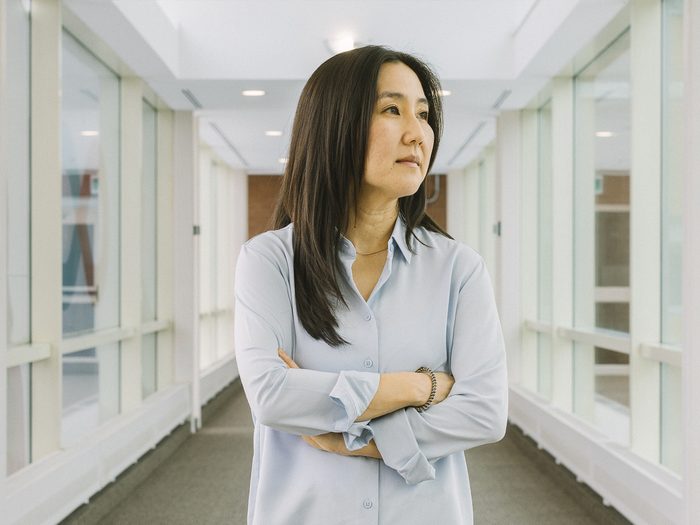When Was the Last Time You Donated Blood?

Canadians talk a big game about the value of donating blood—60 percent of us said it was important to do—but when it comes to actually rolling up a sleeve, only four (four!) percent of us actually do it. This expert explains why.
In June 2022, our national supply of blood was at its lowest in a decade. That’s especially worrying when the inventory has such a short shelf life: six weeks for red blood cells, and just five to seven days for platelets, the tiny cell fragments that help with clotting.
Giving blood can be challenging for all sorts of reasons, from the needle itself to the hour-long time commitment to the fact that Canadian Blood Services (CBS) restricts who can donate. Residual fears over the possibility of HIV transmission through transfusions meant that, until 2016, people who were born or had lived in certain African countries, including Nigeria and Chad, were prevented from donating blood, while men who have sex with men had to contend with revolving restrictions, from an outright ban that lasted until 2013 to various abstinence requirements (five years, one year, three months) before last September. As HIV-detection tests improved, and the tests became cheaper and more readily available, these bans became difficult to defend, and CBS has finally scrapped asking questions about gender or sexual orientation. Now, all potential donors are asked to wait at least three months after having anal sex with a new partner (or multiple) before they donate.
“Evidence has evolved, test technology has advanced and, at the same time, awareness of the importance of an inclusive blood system has increased,” says Jennie Haw, a social scientist at the CBS whose research includes non-donor, donor and donation policy and the social and political contexts of donation.
Here, Haw explains why the start of the pandemic was such a banner time for giving blood, why it matters to have donors from a diverse range of ethnic and genealogic communities and why our supply problem probably won’t be fixed by handing donors a VR headset.

Let’s start with a big one: Why do we need people to donate blood?
So that we have blood and blood products for patients who need it. That can be because of accidents or in trauma care; it can be for many kinds of surgery. There are also conditions for which regular blood transfusion or red-cell exchange is necessary for treatment. Canada has said we’re going to have a voluntary, unpaid system. And so to meet the needs of patients, we need people to donate blood.
What actually brings people through the door to donate?
When you ask donors why they donate blood, the vast majority say it’s because they want to help someone else. There is a psychological phenomenon called a warm-glow effect, where people feel good because they’ve done something good. Another motivation has to do with social recognition: It’s something that’s valued in one’s community; it’s considered to have social capital. And then there’s a kind of reciprocity—someone might know someone who needed blood, so they want to contribute, too.
At the very start of the pandemic, there was a surge in blood donations in Canada. Do crises tend to galvanize people?
Absolutely. Across most national emergencies, you’ll see an upswing in people wanting to help. In the States, after 9/11, there was a massive outpouring of people donating blood, and I know when there are bushfires in Australia, people turn out as well. A colleague and I did a small study in the early days of the pandemic to understand the experiences of people coming out to donate. We found that, for a lot of donors, this was an important opportunity for them to be able to actually interact safely with people who weren’t in their household. Maintaining community was important to them, and this was a way to do that.
Why don’t people donate? What makes it a challenge—or makes it unappealing—for them?
Right now, as restrictions have loosened, I think people have other activities they could be involved in. But more broadly, it’s a really interesting puzzle, and an area where I think we need more research. It’s definitely easier to ask someone “why do you do this?” than it is to understand a phenomenon where something isn’t being done. One way to study why people don’t donate is to look at barriers to donation. It could be a lack of knowledge of the process of blood donation—so not quite understanding how to register, what happens when blood is drawn, what happens to the blood afterward. There can be barriers at a personal level, like a fear of needles. And then there can be systemic barriers, like a lack of trust with the blood operator and a lack of trust with the health-care system, which extends to a lack of trust in the blood system.
There have also been outright bans on certain donors—for example, men who have sex with men, or, up until 2016, anyone born in specific African countries. What impact did those restrictions have on donor engagement?
I haven’t studied that restriction specifically, but sometimes when eligibility criteria change, people don’t necessarily know and it can take time for people affected to be aware of that change.
But when CBS changes a policy about donation, shouldn’t it be responsible for outreach to the people affected?
This is kind of outside the scope of the work I do. But I think any institution or organization asking for people to come and participate voluntarily would want to make sure that the general public knows when there are changes to eligibility criteria.
Why is it important to have donors from different backgrounds?
For a condition like sickle cell disease, one of the treatments is regular blood transfusion or red-cell exchange. And for people who have more rare blood types or are frequently transfused, the closer the blood type matches with the donor, the better the health outcomes. Because blood antigens are inherited, you’re more likely to find a close blood-type match with someone who shares an ethnic ancestry. This doesn’t mean that you can only donate to someone of the same ethnic ancestry—but the more ethnically diverse the donor base, the better positioned Canadian Blood Services is to find close matches for the very diverse population that they serve.
How can we make donor screening as inclusive as possible?
It takes a multidisciplinary approach and a team of people to move donor screening toward inclusivity in a safe way. It requires clinicians and epidemiologists to look at the various risk factors and how to ensure the safety of the blood supply. Plus social scientists to examine the questions asked to be sure they are understandable and accessible. For example, in September, a change was made to ask about sexual behaviour regardless of gender or sexual orientation, and to be more inclusive of gay, bisexual and other men who have sex with men. But it’s a big challenge. And there isn’t necessarily a one-size-fits-all answer.
What about just paying people for their blood?
I know there’s research being done on incentives to donation, and paying donors is one of those options. I don’t know what the impact of paying donors would be.
Speaking of incentives: Las Vegas just introduced a virtual-reality experience for donors. Maybe Canadian Blood Services wants to look into that?
I didn’t know about Las Vegas incorporating VR, but if it was going to happen somewhere, it’d be Vegas. It’s important to keep in mind that the U.S. has a very different system than we have here in Canada. There has been some research looking into whether providing donors with added information—like their cholesterol levels or blood pressure—makes a difference in donor retention, and I think the jury was out on that. I can see how exciting, attractive measures might help a very pressing blood shortage in the moment. But understanding people’s motivations and the social norms underpinning a voluntary blood-donation system—it’s just a vast area of research. I don’t think it’s going to be solved through VR.




